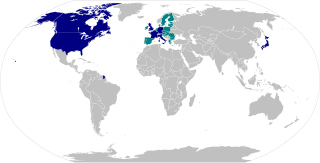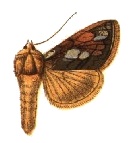Related Research Articles

Lepidoptera is an order of insects that includes butterflies and moths. About 180,000 species of the Lepidoptera are described, in 126 families and 46 superfamilies, 10 per cent of the total described species of living organisms. It is one of the most widespread and widely recognizable insect orders in the world. The Lepidoptera show many variations of the basic body structure that have evolved to gain advantages in lifestyle and distribution. Recent estimates suggest the order may have more species than earlier thought, and is among the four most speciose orders, along with the Hymenoptera, Diptera, and Coleoptera.

Moths are a paraphyletic group of insects that includes all members of the order Lepidoptera that are not butterflies, with moths making up the vast majority of the order. There are thought to be approximately 160,000 species of moth, many of which have yet to be described. Most species of moth are nocturnal, but there are also crepuscular and diurnal species.

Bombyx mori, the domestic silk moth, is an insect from the moth family Bombycidae. It is the closest relative of Bombyx mandarina, the wild silk moth. The silkworm is the larva or caterpillar of a silk moth. It is an economically important insect, being a primary producer of silk. A silkworm's preferred food are white mulberry leaves, though they may eat other mulberry species and even the osage orange. Domestic silk moths are closely dependent on humans for reproduction, as a result of millennia of selective breeding. Wild silk moths are different from their domestic cousins as they have not been selectively bred; they are thus not as commercially viable in the production of silk.

Morus, a genus of flowering plants in the family Moraceae, consists of diverse species of deciduous trees commonly known as mulberries, growing wild and under cultivation in many temperate world regions. Generally, the plant has three main species ostensibly named for the fruit color of the best-known cultivar: white, red, and black mulberry, with numerous cultivars, but more than 200 species are identified in taxonomy. The name “white mulberry” came about because the first specimens named by European taxonomists were a cultivated mutation prized for their white fruit, but wild trees bear black fruit like other mulberries. White mulberry is native to South Asia, but is widely distributed across Europe, Southern Africa, South America, and North America. It is regarded as an invasive species in Brazil and the United States.

The de Havilland Aircraft Company Limited was a British aviation manufacturer established in late 1920 by Geoffrey de Havilland at Stag Lane Aerodrome Edgware on the outskirts of north London. Operations were later moved to Hatfield in Hertfordshire.

Attacus atlas, the Atlas moth, is a large saturniid moth endemic to the forests of Asia. The species was first described by Carl Linnaeus in his 1758 10th edition of Systema Naturae.

The Group of Seven (G7) is an intergovernmental organization consisting of Canada, France, Germany, Italy, Japan, the United Kingdom and the United States. The heads of government of the member states, as well as the representatives of the European Union, meet at the annual G7 Summit.

The Hepialidae are a family of insects in the lepidopteran order. Moths of this family are often referred to as swift moths or ghost moths.

The de Havilland DH.60 Moth is a 1920s British two-seat touring and training aircraft that was developed into a series of aircraft by the de Havilland Aircraft Company.

Gracillariidae is an important family of insects in the order Lepidoptera and the principal family of leaf miners that includes several economic, horticultural or recently invasive pest species such as the horse-chestnut leaf miner, Cameraria ohridella.

The DH.83 Fox Moth was a successful small biplane passenger aircraft from the 1930s powered by a single de Havilland Gipsy Major I inline inverted engine, manufactured by the de Havilland Aircraft Company.

Galacticidae is a recently recognised and enigmatic family of insects in the lepidopteran order. These moderate sized moths are 8–17 mm in wingspan and have previously been embedded within several lepidopteran superfamilies, but Galacticidae is currently placed in its own superfamily at the base of the natural group Apoditrysia.

Schinia, commonly called flower moths, is a large genus of moths belonging to the family Noctuidae. The genus has a Holarctic distribution with the vast majority of species being found in North America, many with a very restricted range and larval food plant.

HMS Moth was an Insect-class gunboat of the Royal Navy. Entering service in 1916, Moth had a varied career with service in the Middle East, the White Sea and the Far East in two world wars. Scuttled in World War II during the invasion of Hong Kong, the ship was raised and put into service by the Imperial Japanese Navy as Suma (須磨). The ship remained active throughout the war, before striking a naval mine in the Yangtze River in 1945 and sinking.

Cephonodes hylas, the coffee bee hawkmoth, pellucid hawk moth or coffee clearwing, is a moth of the family Sphingidae. The species was first described by Carl Linnaeus in 1771. A widely distributed moth, it is found in the Near East, Middle East, Africa, India, Sri Lanka, Japan, Southeast Asia and Australia.

Actebia fennica, the black army cutworm or Eversmann's rustic, is a moth of the family Noctuidae. The species was first described by August Michael Tauscher in 1806. It has a Holarctic distribution from Newfoundland through western Europe, Siberia, the Far East, Mongolia, northern China to Korea and Japan. In North America it is mainly found in the boreal region, south to New England, southern Montana and northern Oregon.

Plusia putnami, the Lempke's gold spot or Putnam's looper moth, is a species of moth of the family Noctuidae. It is found in the Palearctic realm, from Japan and eastern Siberia to Fennoscandia, Great Britain, and France. In North America, it ranges from Newfoundland and Labrador to central Alaska and the interior of British Columbia, south to Pennsylvania, Washington, north-eastern California, and in the Rocky Mountains to Utah and Colorado.

Dichomeridinae is a subfamily of moths in the family Gelechiidae.
William Warren was an English entomologist who specialised in Lepidoptera.
Akito Y. Kawahara is an American and Japanese entomologist, scientist, and advocate of nature education.
References
- ↑ Beccaloni, G.; Scoble, M.; Kitching, I.; Simonsen, T.; Robinson, G.; Pitkin, B.; Hine, A.; Lyal, C., eds. (2003). "Tyriozela". The Global Lepidoptera Names Index . Natural History Museum.
- ↑ Japanese Moths
| This Heliozelidae-related article is a stub. You can help Wikipedia by expanding it. |